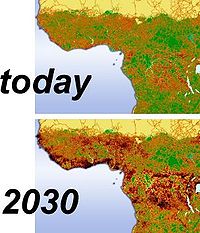
Photo from wikipedia
European hedged agricultural landscapes provide a range of ecosystem services and are an important component of cultural and biodiversity heritage. This paper investigates the extent of hedges, their woody species… Click to show full abstract
European hedged agricultural landscapes provide a range of ecosystem services and are an important component of cultural and biodiversity heritage. This paper investigates the extent of hedges, their woody species diversity (including the influence of historical versus recent hedge origin) and dynamics of change. The rationale is to contribute to an ecological basis for hedge habitat management. Sample sites were allocated based on a multivariate classification of landscape attributes. All field boundaries present in each site were mapped and surveyed in 1998 and 2007. To assess diversity, a list of all woody species was recorded in one standard 30 m linear plot within each hedge. There was a net decrease in hedge habitat extent, mainly as a result of removal, and changes between hedges and other field boundary types due to the development and loss of shrub growth-form. Agricultural intensification, increased rural building, and variation in hedge management practices were the main drivers of change. Hedges surveyed at baseline, which were lost at resurvey, were more species rich than new hedges gained. Hedges coinciding with historical land unit boundaries of likely Early Medieval origin were found to be more species rich. The most frequent woody species in hedges were native, including a high proportion with Fraxinus excelsior, a species under threat from current and emerging plant pests and pathogens. Introduced species were present in circa 30% of hedges. We conclude that since hedge habitat distribution and woody species diversity is a function of ecology and anthropogenic factors, the management of hedges in enclosed agricultural landscapes requires an integrated approach.
Journal Title: Journal of environmental management
Year Published: 2017
Link to full text (if available)
Share on Social Media: Sign Up to like & get
recommendations!